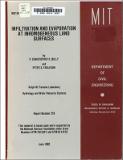Infiltration and Evaporation at Inhomogeneous Land Surfaces
Author(s)
Milly, P. Christopher D.; Eagleson, Peter S.
Download09572378.pdf (5.942Mb)
Metadata
Show full item recordAbstract
The local response of the land surface to atmospheric forcing is determined by the surface parameters, the surface state, and the forcing. Because these factors are highly variable at length scales smaller than those of many hydrologic analyses, and because they enter nonlinearly into the hydrologic response functions, the calculation of areal average response in terms of real physical parameters is non-trivial. Treating an inhomogeneous soil surface as a battery of independent, parallel soil columns, we calculate the areal average infiltration that results from a spatially variable storm event. The spatial variability of soil and storm properties turns out to be critical in shaping the infiltration function for an inhomogeneous basin. A particular feature of the average response is that increased spatial variability of soil type or of storm depth almost invariably leads to decreased infiltration and increased surface runoff. The calculation of the areal average evapotranspiration rate is complicated by atmospheric advection, which provides a feedback mechanism whereby the downstream evaporation is influenced by the upstream. The upstream influence may persist over a fetch of hundreds of kilometers. A conceptual model of the atmospheric boundary layer is developed and applied to the analysis of evapotranspiration from a surface whose supply of water and energy may be characterized by spatially variable canopy resistances and available energies (net radiation minus heat flux into the ground). The surface roughness is also considered to be variable in space. An explicit dependence of areal average evapotranspiration upon the patch size -- the characteristic length of the variability -- is derived. The effect of local advection is shown to be most significant when there is a great variation of the canopy resistance between patches. Otherwise, the individual patches behave in a relatively independent manner. This points to the importance of spatial variability of the water supply in the analysis of areal average evapotranspiration.
Description
This material is based upon work supported by the National Science Foundation Under Grant Numbers ATM-7812327 ATM-8114723
Date issued
1982-06Publisher
Cambridge, Mass. : Report / Ralph M. Parson Laboratory, Hydrology and Water Resource Systems, Dept. of Civil Engineering, School of Engineering, Massachusetts Institute of Technology
Other identifiers
278
Series/Report no.
R (Massachusetts Institute of Technology. Department of Civil Engineering) ; 82-34.Report (Ralph M. Parsons Laboratory for Water Resources and Hydrodynamics) ; 278.